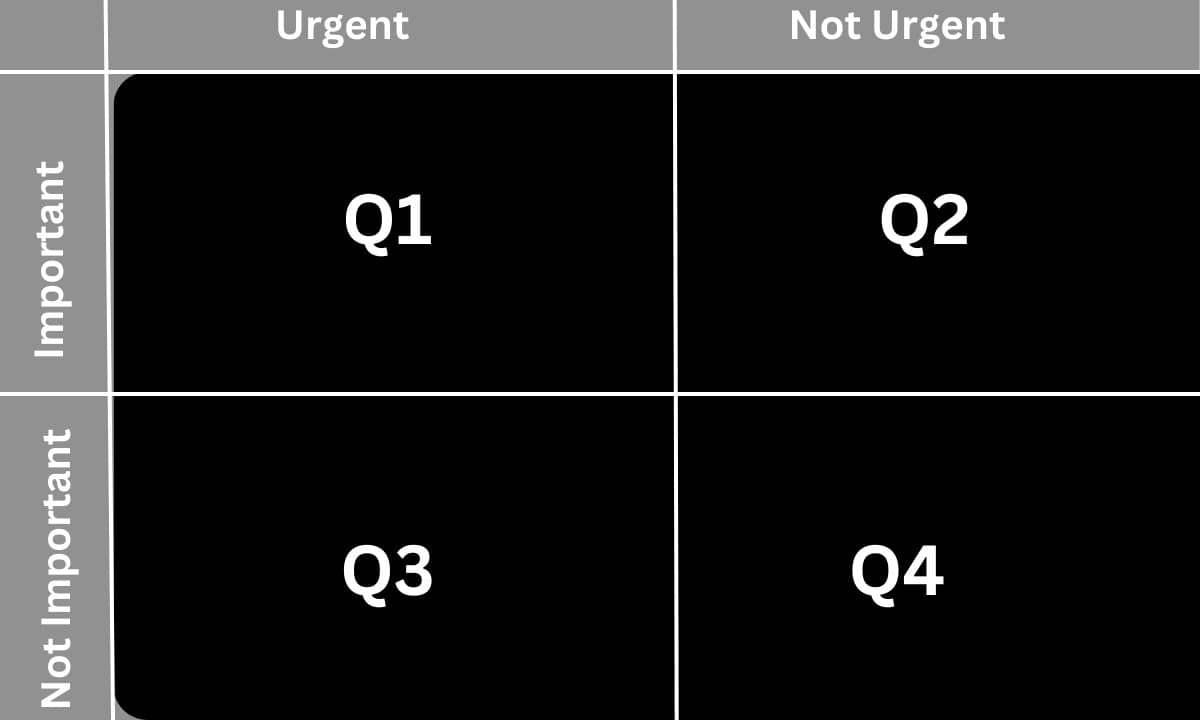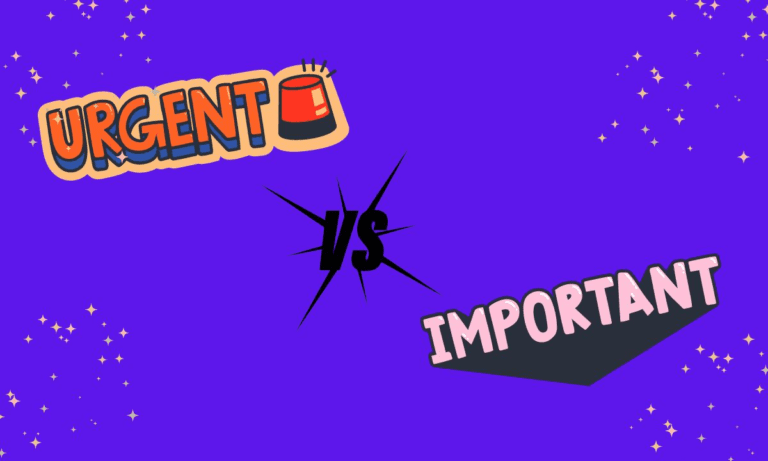The 4 Quadrants of Time Management Matrix + Useful Printables

Do you often find yourself stuck at work, juggling tasks that never seem to end? It’s a common problem—balancing urgent deadlines with long-term projects is challenging. Frustration mounts; productivity declines. Imagine if there were a clear system to prioritize your tasks, reducing stress and increasing efficiency.
Welcome to the 4 quadrants of the Time Management matrix. Originally developed by Stephen Covey, this method transforms chaos into order, guiding you not just to work hard, but also smart. In this guide, discover how to categorize activities effectively and reclaim control over your time and your life.
Here are a few time management charts to navigate your day/week effectively(over 10+ printable versions available).

Why is time management so important?
You know the drill: your day’s packed before it starts, and tasks are spilling over. Meetings, emails, deadlines—it can get too much. Now, imagine flipping the script: the important work is done, your inbox is clear, and you leave on time.
Good time management skills clear the clutter and focus your energy on urgent tasks, providing room for relaxation. Picture ending your day feeling accomplished, with your tasks completed and time to spare.
It’s about working smarter, not harder. So, why wait? Start your journey towards effective time management today, and watch your days transform from overwhelming to under control.
An Introduction to Time Management Matrix: A way to manage tasks smoothly

Task overload can leave you feeling lost. That’s when the Time Management matrix can come in handy. Start with making a clear list of everything you have to do. Then, sort them into one of the 4 boxes in the matrix. This step helps you see which tasks are vital and which ones can wait.
The point is to focus on what matters most, so you don’t get tangled up in less necessary tasks. With everything neatly arranged in the matrix, your workload becomes much easier to handle. This method turns a messy to-do list into a clearer, more organized day.
How to use the Stephen Covey Time Management Matrix
Harness the Stephen Covey Time Management matrix (also called the Eisenhower matrix) to revolutionize your day-to-day organization. Start by labelling your tasks according to the four quadrants—urgent and important, important but not urgent, urgent but not important, and neither urgent nor important.
With your tasks mapped out, prioritize Quadrant 1 to manage crises and deadlines. Schedule Quadrant 2 tasks for strategic planning and important projects, ensuring continuous personal and professional development. Be efficient with Quadrant 3 by delegating or speeding through interruptions and minor tasks, and finally, minimize or eliminate Quadrant 4 – this is your reclaimed time.
By adjusting your daily plan to fit this matrix, you’re not just crossing off tasks—you’re deliberately choosing to spend your time on what truly enriches your life and moves you towards your goals. Give it a try and watch as chaos turns into structured progress that aligns perfectly with your life’s ambitions.

Make a list of the tasks you need to do
To use the Stephen Covey Time Management matrix effectively, make a holistic list of your daily tasks. These tasks form the base for your quadrant classification.
Review each task’s importance and urgency, and place them in the correct quadrant. Be honest about their significance to your life goals. Using the matrix, you can reduce low-priority tasks and prioritize valuable activities.
This condensed yet potent tool empowers you to refine your day-to-day tasks, helping you strike a work-life balance. Utilizing the matrix is a strategic step towards effective time control.
Enlist the tasks with deadlines
Within your task list are surely items bound by time. Highlight deadlines and fixed-date commitments – these often fall under Quadrant 1 or 3, typically marked urgent.
This step not only prevents last-minute rushes but also aids in prioritizing effectively, ensuring you never miss a beat on the essentials.
Identify your big rocks
“Big rocks” are a metaphor for your most important tasks and priorities, typically falling in Quadrant 1 and 2. These tasks contribute significantly to your personal and professional growth. As you classify your tasks, pinpoint these high-value pursuits.
By recognizing your big rocks, you’ll be able to strategically allocate time and resources, ensuring that the meaningful aspects of your life receive the attention they deserve, while not being overshadowed by the less critical tasks.

Scheduling big rocks
After identifying your “big rocks,” the key is to integrate them into your schedule. Allocate specific times during the week for these indispensable tasks. Guard these time slots diligently, as you would appointments, to ensure that your highest priorities are addressed.
By planning around your big rocks first, you’ll ensure they don’t become an afterthought. This strategy not only prompts you to commit to these tasks but also helps in carving out time for your most impactful activities.
Include deadlines
Setting deadlines for major tasks transforms your time management. Assigning deadlines promotes urgency and accountability. Treat these deadlines like important meetings, integrating them into your calendar. This strategy curbs procrastination and enhances discipline, driving a significant uptick in productivity.

Learn to let go
In the pursuit of effective time management, not all tasks will be cut. Some will fall into Quadrant 4, tasks which are neither urgent nor important. Learning to let go or delegate these tasks can free up significant time for more meaningful and critical activities.
This doesn’t mean neglecting responsibilities but rather recognizing where your time and effort yield the highest value. As you apply the Stephen Covey Time Management matrix, this art of letting go becomes vital to maintaining your focus on what matters.
Identify your priorities
Defining your priorities plays a crucial role in effective time management. Once you’ve understood where your time is currently invested, you’ll need to recognize what truly deserves your attention. The Covey Time Management matrix promotes the identification of activities that align most closely with your personal and professional ambitions.
These priorities usually fall into quadrants 1 and 2. The art of prioritization involves recognizing the most impactful tasks and devoting your energy to these above all else. Operationalizing this step will ensure you’re on the right path to accomplishing your goals.
Increasing Productivity with the Time Management Matrix

Implementing the Time Management matrix amplifies productivity by distinguishing between important and non-important, and urgent versus non-urgent tasks, encouraging smarter work.
The principle lies in reducing time spent in quadrants 3 and 4 — the areas of deception and waste. By focusing more on Quadrant 2, which encourages proactive, high-value activities, you’ll foster habits that lead to productivity growth, effectiveness, and a healthier work-life balance.
Increased productivity through Attention-seeking Distractions
Ironically, attention-seeking distractions can boost productivity when managed wisely. Schedule short, deliberate breaks and tackle lower-priority tasks during these intervals. This prevents burnout while still addressing non-critical tasks and maintaining momentum throughout the day.
What Types of Tasks Should I Focus on in Each Quadrant of the Time Management Matrix?
The key to leveraging the Time Management matrix is understanding what tasks belong in each quadrant and how to approach them:
- Quadrant 1 – Urgent and Important: These tasks require immediate attention and often relate to critical deadlines or emergencies. Focus here but try to minimize these by planning.
- Quadrant 2 – Not Urgent but Important: These are activities that contribute to your long-term mission, values, and goals. Investing time in this quadrant is essential for growth and includes strategic planning, relationship building, and self-improvement.
- Quadrant 3 – Urgent but Not Important: These distractions require immediate attention but do not contribute to your objectives. If feasible, assign them to others and strive to minimize such occurrences by establishing limits.
- Quadrant 4 – Neither Urgent Nor Important: Typically, these are time-wasters and trivial tasks. Limit or eliminate these activities as they contribute little to no value and distract from higher priorities.
Advantages and Application of Time Management Matrix
The Time Management matrix offers numerous benefits when applied effectively. It helps identify priorities, improves decision-making, and promotes proactivity. The matrix divides tasks focusing on urgent important matrix and limit tasks that are time-wasters, you increase productivity and reduce stress.
The matrix also fosters personal and professional growth by encouraging time investment in long-term goals, skill development, and relationship nurturing.
Can the time management matrix be used in personal as well as professional settings?

Absolutely! The Time Management matrix is a versatile tool applicable to both personal life and professional scenarios. Whether managing your household, planning a vacation, studying, or working on a project at work, the matrix will help you prioritize all your tasks effectively based on their urgency and importance.
Create your custom time management matrix today
Don’t wait — start crafting your proper Time Management matrix. By doing so, you’ll spearhead an action plan designed to help manage your time intelligently, catered uniquely to your needs.
The benefits of using the Stephen Covey Time Management Matrix
The matrix offers a multitude of benefits, ranging from enhancing organization skills to improved planning capabilities.
Helps you to be organized
By categorizing tasks based on their urgency and importance, the matrix helps to clear the clutter from your mind and promotes a systematic approach towards your to-dos.
Learn to say no to less important things
The matrix will help you identify less important and time-consuming activities. This newfound awareness allows you to decline tasks that don’t align with your priorities, making more room for those that do.
Keep checking your score every week
Monitor your progress regularly by revisiting the matrix and analyzing the time spent in each quadrant. This practice keeps you accountable and offers insights for improvement.
Develop planning skills
The Time Management matrix enhances your planning skills by urging you to think critically about each task’s urgency and importance, promoting a proactive mindset.
Let you know what is most important
One of the greatest benefits of the matrix is its ability to help you pinpoint your most important tasks. This clarity assists in aligning your actions with your long-term goals and values, both personally and professionally.
Combine the Time Management Matrix with a Powerful Scheduling App

Integrating the Time Management matrix with a scheduling app enhances your planning. By categorizing tasks within an app, you easily visualize and prioritize.
This combination enables you to focus on important activities, alerting you to deadlines and providing a digital nudge for personal development. It’s a simple yet effective way to keep your to-dos in check and make every moment count.
How can the time management matrix help me improve my productivity and efficiency?
The Time Management matrix can significantly elevate your productivity and efficiency. By categorizing tasks into four quadrants based on urgency and importance, it allows for strategic prioritization. You’re motivated to concentrate on crucial tasks, which directly impact your goals or deadlines.
Secondly, it helps identify unnecessary “time-wasters,” paving the way for efficient delegation or outright decline. With a focus on tasks that matter and a reduction of irrelevant activities, your productivity sees a substantial uplift. And as this becomes a habit, you’ll notice improved efficiency in task completion.
How do I know if I’m spending too much time in one quadrant of the time management matrix?
Detecting excess time spent in a quadrant often requires self-reflection and monitoring. If you find yourself frequently rushing to meet deadlines, consistently stressed, or putting out fires, you might be spending too much time in Quadrant 1.
If your day is filled with interruptions and other people’s priorities, you’re likely stuck in Quadrant 3. Spending too much time in Quadrant 4 is usually seen through consistent procrastination and lack of progress towards your important goals. If any of these scenarios sound familiar, it’s time to reassess your approach and redistribute your time more effectively.
Author Bio:
Varun Sanghai’s unique perspective touches on a broad range of personal finance matters, weaving together topics from loans to fintech. His writing skillfully ignites conversations about wise financial conduct and efficient time management, guiding readers along their path to success.
Here are some helpful job interview related blogs
- Tackling the final interview round
- How to answer ‘tell me about yourself’
- What are your career aspirations?
- Where do you see yourself in five years
- Why do you want this job?
- Strengths and Weaknesses In Interview
- Interview questions for managers
- Interview questions for freshers
- Tips to succeed in a job interview
- Do you need an Career coach / Interview coach?
Here’s some helpful career/leadership related blogs
- Careers– Agile Coach, RTE, Product Owner, Scrum Master, QA Manager
- Career development plan
- Career growth
- Project Management
- Managing Managers
- IT Career switch
- Software Engineering career path
- Agility, Agile Testing
- Remote leadership / Leadership traits / Agile leadership
Other Productivity / Tools posts that may interest you
- Productivity
- Book summary apps – Headway App vs Blinkist vs getAbstract
- AI Writers: / Blogging – Jasper, Writesonic, Article Forge , Copy AI, Anyword, Writecream, Copymatic, Quillbot, Peppertype, Jasper AI (pricing) &
- Work From Home tools: Jabra
Author also writes at his Medium site.





